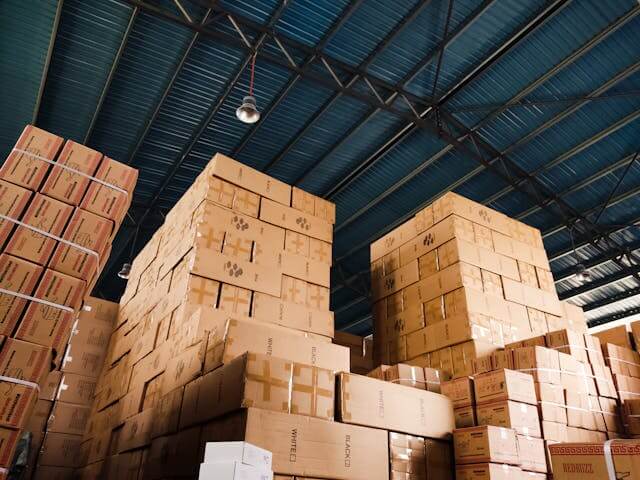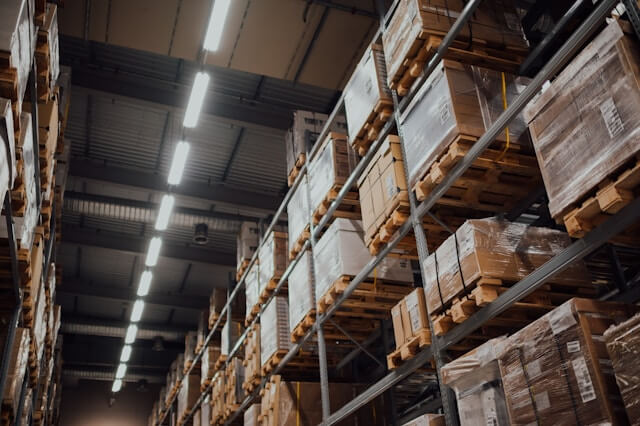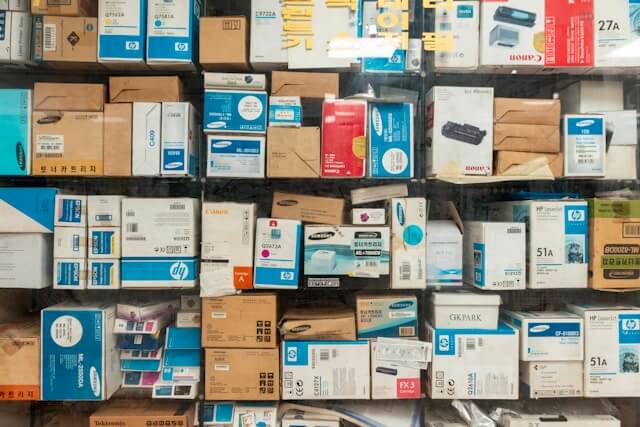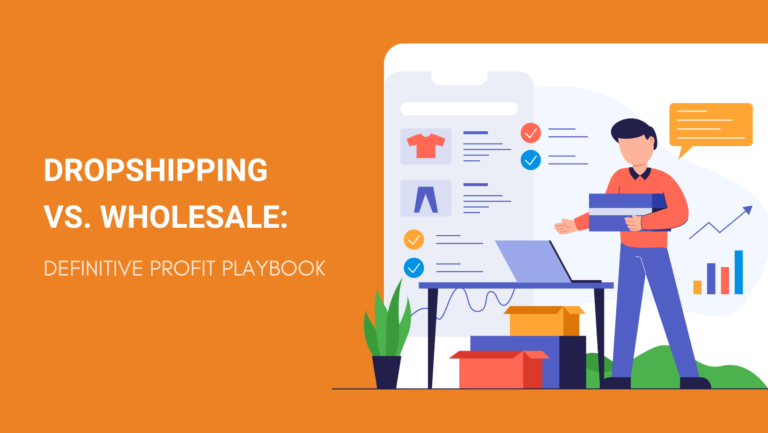In the evolving landscape of retail, e-commerce has introduced more ways than ever for entrepreneurs to connect with customers.
Two popular business models dominate the online marketplace: dropshipping and wholesale. These models are crucial for understanding how to navigate the world of online sales and manage the supply chain effectively.
Dropshipping allows you to start a business with minimal upfront costs by selling products that are shipped directly by the supplier, while wholesale involves purchasing inventory in bulk and handling the shipping yourself.
Both have unique benefits and challenges that can impact your journey as an online retailer. Choosing between starting a dropshipping or a wholesale business can profoundly affect your approach to e-commerce.
This article aims to help you grasp the subtleties of each model by comparing them against various factors such as startup costs, risk levels, and potential for scalability.
By the end of this, you’ll have a clearer view of which path best aligns with your business goals and resources. Our objective is to empower you with information that makes your decision-making process easier and more informed.
Key Takeaways
- Dropshipping offers a low barrier to entry, while wholesale requires more upfront investment.
- Wholesale allows for greater control over inventory, whereas dropshipping relies on supplier stock.
- Both models present different risks and scalability opportunities that must be considered.
What Is Dropshipping?

Dropshipping is an eCommerce model that allows you to sell products to your customers without requiring physical inventory.
Instead, you transfer your customers’ orders and shipment details to either a manufacturer or a wholesaler, who then sends the goods directly to the customer.
In dropshipping, you act as a storefront that markets products for sale but doesn’t physically house any items.
When an order is placed on your online business, the fulfillment process is handed over to dropshipping suppliers. These suppliers maintain their own inventory management systems and ensure the product reaches the customer.
Pros
- Low Entry Barrier: You can start an online store quickly without needing a large upfront investment.
- Minimal Initial Investment: Typically, you don’t need to purchase inventory, leading to lower initial costs than traditional retail models.
- No Inventory Carrying Costs: Since you’re not stocking products, there are no associated storage expenses.
- Flexibility to Offer a Wide Variety of Products: You can list and sell items from many suppliers, extending your product range effortlessly.
Cons
- Lower Profit Margins: With reduced risks come smaller margins compared to wholesale, as suppliers set higher prices to offset their holding costs.
- Less Control Over Supply Chain: You depend on third-party suppliers, potentially leading to supply consistency issues.
- Dependency on Third-Party Suppliers: This can adversely impact product quality and customer satisfaction if the supplier fails to meet Standards.
What Is Wholesale?

Wholesale is the process of purchasing products in bulk directly from manufacturers or distributors.
It serves as the foundation for many retail operations, allowing you to buy goods in larger quantities at a discounted rate from manufacturers, benefiting from economies of scale.
You benefit from lower prices because goods are bought in high volume, which can then lead to a larger profit margin when these items are sold to retailers or directly to customers.
Pros
- Higher profit margins per unit: Buying at a lower price means you can turn a higher profit per item sold.
- Control over inventory: You maintain full authority over stock levels and can manage supplies according to demand.
- Direct supplier relationships: Establishing connections with suppliers may provide advantages like exclusive product access.
- Discounts on large quantities: The more you buy, the more you can save, which can significantly reduce the cost per item.
Cons
- Substantial initial investment: Acquiring a large volume of stock all at once requires more capital upfront.
- Risk of overstocking: Predicting demand is tough, and misjudgment can lead to excess inventory.
- Need for storage space: Holding inventory means you’ll need ample space to store it, which might include renting a warehouse.
- Significant upfront costs: Beyond purchasing inventory, you must also consider costs for logistics and management of goods.
Dropshipping vs Wholesale: Comparison by Features
When you’re considering starting an online business, choosing between dropshipping and wholesale is pivotal. Each model offers distinct advantages and challenges.
Below is a feature-based comparison to help you discern which path may suit your entrepreneurial journey better.
1. Ease of Entry
When you’re considering starting your own online store, the ease with which you can enter the market is a crucial factor. Dropshipping and wholesale are two prevalent business models, each with its own entry requirements.

Dropshipping is often seen as the more accessible option for entrepreneurs due to its lower initial costs. With dropshipping, you won’t need to purchase large quantities of inventory upfront.
This model allows you to partner with a third-party supplier who will handle the inventory and shipping directly to customers when you make a sale.
On the other hand, wholesale purchasing requires a more substantial upfront investment. To secure wholesale prices, you need to buy products in bulk.
This means having capital ready to invest in inventory. However, this business model gives you more control over your products, which could lead to higher profit potential in the long run.
In summary, for someone looking to start an eCommerce business with limited funds, dropshipping might be the more suitable path.
If you have more capital to invest and desire greater control over your products and operations, then wholesale may be the right choice for you.
2. Startup Costs
When embarking on an eCommerce venture, understanding the startup costs is crucial for success. You’ll see a stark difference between the financial thresholds required for dropshipping as opposed to wholesale.
In dropshipping, the initial investment is substantially lower. Since you won’t be holding any inventory, there are almost no upfront costs.
Your primary expenses will involve setting up your online store, including website creation and a subscription fee for an eCommerce platform. An advantage you have here is that you pay for products only when customers place orders.
| Dropshipping Costs | Estimated Amount |
| Website Setup | $100 – $300 |
| eCommerce Platform Subscription | $20 – $80/month |
When it comes to wholesaling, the situation differs. You must be prepared for a more substantial initial investment because you’ll need to buy stock in bulk, which requires significant capital.

Additionally, warehouses or storage facilities for your inventory will add to the overhead costs. Employee salaries and administrative expenses are part of the equation too.
| Wholesale Costs | Estimated Amount |
| Inventory Purchase | $5,000 – $10,000+ |
| Warehouse Rent | $1,000 – $2,000/month |
| Additional Overhead (Staff, Admin) | Variable |
Choosing between dropshipping and wholesale will depend on your financial readiness and risk appetite. Before making a decision, consider how much you’re willing to invest and the cash flow implications.
3. Product Selection and Variety
When it comes to the products you can sell, the dropshipping model provides a unique advantage. You have the flexibility to offer a wide array of products from various suppliers.
This means that your online store can quickly adapt to trends without inventory constraints. If a product isn’t selling, you can easily replace it with a better option, making your product offering dynamic and responsive.
In contrast, with wholesale, the product selection might seem limited as you have to buy items in bulk. However, this could translate to exclusivity in your offerings.
Wholesalers often have more sway in the type of products available, allowing for more careful curation.
For instance, if you aim to differentiate your brand, wholesale might provide a range of product options not readily found in dropshipping networks.
It’s important to note that while dropshipping allows you to easily expand your product line, the challenge lies in ensuring the quality and consistency of the products since you’re not handling them directly.
Meanwhile, wholesale might involve more upfront work to establish your product base, but the payoff includes building a distinctive brand with products that you’ve vetted and believe in.
In summary, the choice between dropshipping and wholesale comes down to your preference for variety and control.
Dropshipping offers a broad selection without the risk of unsold stock, whereas wholesale demands careful product choice and investment but rewards with distinctiveness in your market.
4. Profitability

When you’re deciding whether to invest in dropshipping or wholesale, understanding profitability is key. Here’s the lowdown:
Dropshipping:
- Profit Margins: Typically lower, because the dropshipper takes a cut of your sales. You’ll need to sell high volumes to make a significant profit.
- Products: You might be selling the same products as others, which can impact your profit potential.
Wholesale:
- Profit Margins: Higher potential, as purchasing in bulk typically reduces the cost per item.
- Products: You have greater control and can select unique items that might sell at a premium.
In dropshipping, your initial investment might be lower, and it’s straightforward to start up.
However, wholesale offers the possibility of earning more per item. You’ll invest more upfront and need space for inventory, but this control can lead to larger profit margins.
Your business strategy and financial goals are crucial when choosing a model. Consider your capacity to handle inventory and whether you aim for volume sales or higher profits per product.
Each model excels in certain circumstances, so align your choice with what makes the most sense for your business’s growth.
5. Risk Level
The risks in dropshipping and wholesale business models are largely associated with financial commitments and supply chain complexities.
Dropshipping involves lower initial financial risk, as you don’t have to invest heavily in stock.
However, because you’re at the mercy of third-party suppliers for product availability and shipping times, you face operational risks. Unexpected delays or stock shortages on your supplier’s end could impact your customer satisfaction.
In wholesale, your risks shift. Financially, you’re investing more upfront in purchasing large quantities of stock. This approach ties up your capital, which could have been used elsewhere, and if the products don’t sell, you might face a loss.

However, having the stock in your possession allows for more control over the supply chain, reducing the risk of stock-outs and fulfillment delays.
| Dropshipping Risks | Wholesale Risks |
| Lower financial risk | Higher financial risk |
| Supplier reliability | Overstocking unwanted inventory |
| Inventory availability issues | More upfront investment |
| Longer shipping times | Shorter shipping times |
| Slimmer profit margins | Potential for higher profits |
It’s important to remember that both models carry their own set of risks, but they can be managed with careful planning and research.
If you’re budget-conscious and prefer a hands-off approach about handling products, dropshipping might be for you. But if you want more control and can manage inventory, wholesale could be the better path.
Consider your own circumstances and choose the model that aligns with your business goals and risk tolerance.
6. Order Fulfillment Process
The order fulfillment process varies significantly between dropshipping and wholesale, affecting both your workload and your customer’s experience.
In dropshipping, when a customer places an order on your website, your role is simply to notify the supplier. The supplier then handles the rest – they pack the product and oversee the shipping process directly to the customer.
You don’t handle the product at all, which minimizes your risk but gives you less control over shipping times and packaging.
Steps in Dropshipping Fulfillment
- The customer places an order on your site.
- You pass the order to the supplier.
- The supplier ships the product directly to the customer.
However, with wholesale, you purchase bulk inventory from suppliers upfront. When a customer orders from your site, you are responsible for storing, packing, and shipping the products yourself.
If you manage it well, this can mean a better customer experience, as you can offer branded packaging and potentially faster shipping.
Steps in Wholesale Fulfillment
- Customer places an order on your site.
- You retrieve the item from your inventory.
- You package and ship the order to the customer.

Understanding these differences helps you assess what fits your business model best. If you seek more control and are willing to manage inventory, wholesale might be for you.
But if you prefer a hands-off approach, especially when just starting, dropshipping could be more appropriate.
Additionally, consider the financial implications; dropshipping often has lower startup costs, while wholesale can lead to higher profit margins if managed effectively.
7. Inventory Management
With dropshipping, you don’t have to worry about stock levels as your supplier handles them. This means you can avoid the costs and hassles of storing large amounts of products.
However, it’s vital to ensure your suppliers keep accurate track of their inventory so you don’t sell out-of-stock items.
In contrast, wholesale requires purchasing and managing inventory, which needs significant storage space. You are responsible for tracking stock levels and reordering products to prevent stockouts.
Effective management here helps maintain the balance between having enough stock to meet demand and not wasting capital on unsold goods.
Remember, in dropshipping, you may face challenges with overselling if the supplier’s inventory management is not up to par.
Conversely, in wholesale, you control your stock, and thus your destiny, but accurate forecasting is essential to strike the right balance.
8. Supplier and Vendor Relationships
In the dropshipping model, your relationship with suppliers is usually less involved. You rely on them to stock items, manage inventory, and ship products directly to your customers.
This means you don’t have to worry about storage or initial capital for inventory. However, because you don’t purchase items in bulk, your margins might be lower due to the supplier’s higher price per unit.
On the flip side, wholesale involves buying products in bulk, often leading to closer relationships with vendors due to the higher stakes.
You are more likely to negotiate better terms, such as discounts or exclusive items, when you commit to larger orders. Moreover, you can leverage these relationships to ensure product quality and dependability, which directly impacts your brand’s reputation.
| Dropshipping | Wholesale |
| Less interaction with suppliers. | Closer, more personalized relationships. |
| Dependence on supplier for inventory and shipping. | Purchase inventory upfront; manage storage and shipping. |
| Potentially lower profit margins per unit. | Bulk discounts may lead to higher profit margins. |
In terms of supplier relationships, dropshipping requires you to trust that the supplier will uphold your brand’s standards without direct control. Meanwhile, in wholesale, you can develop deeper business ties and exercise more influence over the entire process.
When comparing the two, remember that you may prefer the hands-off approach of dropshipping or the control and potential cost savings of wholesale. Both require reliable supplier relationships, which play a critical role in your business’s success.
9. Experience

Dropshipping presents a streamlined process, where you don’t handle the products directly. This can lead to less control over packing and shipping times.
However, you can start selling quickly with minimal upfront cost. Your supplier’s reliability is key, as shipping delays directly affect customer satisfaction.
On the other hand, in wholesale, you purchase items in bulk, giving you hands-on control over inventory and the shipping process.
This often allows for personalized branding options, like custom packaging, which enhances the customer’s unboxing experience and brand loyalty.
With wholesale, your initial investment is higher and you need space for inventory, but you’re rewarded with a greater margin potential.
| Dropshipping | Wholesale | |
| Investment | Low upfront cost | Higher initial investment |
| Control | Less control over shipping | Full control over packaging and shipping |
| Branding | Limited customization | Personalized unboxing experience |
| Profit Margin | Slimmer margins | Potentially higher profit margins |
As you consider these models, think about your capacity to invest and your eagerness to control the customer experience. If you’re new to the business world, dropshipping might suit you as it involves less initial risk.
Seasoned business owners with an established brand might prefer wholesale for its branding benefits and higher profit potential.
In both cases, remember that the customer’s experience can make or break your brand’s reputation. Choose the model that aligns with the value you want to provide to your customers.
10. Scalability
When you start a dropshipping business, scalability often comes with ease. Since you don’t need to handle inventory or manage shipping logistics, you can increase your sales volume without a proportional increase in operational hassle.
Entry is relatively straightforward, and due to the nature of dropshipping, you can quickly add new products to your store. Since the upfront investment and storage requirements are low, scaling up can be more budget-friendly.

However, your growth might be limited by your supplier’s capabilities or your ability to negotiate better deals as your order volume increases.
In contrast, when you start a wholesale business, the scalability factor is closely tied to your ability to invest in inventory and manage larger quantities of products.
While this requires more capital, it also gives you greater control over inventory, potentially leading to higher profit margins. Scaling up in wholesale means being ready to handle increased storage, staff, and pre-purchase more goods.
Here’s a quick comparison to consider:
| Dropshipping | Wholesale |
| (+) Lower initial investment | (+) Greater control over stock |
| (+) Easier to add products | (+) Potential for higher profits |
| (-) Dependent on supplier’s reliability | (-) More capital required for scaling |
| (-) Slimmer profit margins | (-) Increased operational management |
Both models have their own set of challenges when it comes to scaling. Dropshipping allows you to grow with fewer growing pains but less control over your stock.
Wholesale offers more profit potential and stock control, but at the cost of higher initial investment and a more complex operational scaling.
The key to scaling successfully in either model is closely monitoring your business growth and making the necessary adjustments.
11. Branding
Branding is about crafting a unique identity that resonates with your customers, setting you apart from competitors.
In dropshipping, you sell products directly from suppliers. These products often lack unique branding because other retailers also sell them.
You may face limitations in packaging and presenting products to reflect your brand. However, dropshipping platforms allow you to start with less investment, so you can focus more on building an online brand presence.
On the other hand, wholesale buying lets you purchase products in bulk, generally at a lower price per unit. A major advantage here is the level of control you gain over how your products are packaged, presented, and sold.

You can design your own labels, use custom packaging, and ensure that every touchpoint is branded for your store. Wholesaling strategies can lead to a more distinct and memorable branding experience for your customers.
Which should you choose for better branding?
- Dropshipping: More challenging to create unique branding for products.
- Wholesale: Greater control over product presentation, allowing for distinct branding.
Whether you prefer the lower cost of entry in dropshipping or the greater branding control of wholesale, consider how deeply you wish to be involved in bringing your brand to life.
Dropshipping vs Wholesale: Comparison Table
When you’re eyeing the e-commerce arena, it’s crucial to understand the key distinctions between dropshipping and wholesale. Here’s a straightforward table to guide you:
| Feature | Dropshipping | Wholesale |
| Initial Investment | Low, around $100 – $299 | High, need bulk inventory purchase |
| Inventory Management | No need to manage inventory, outsourcing is possible | Requires space & management for large inventory |
| Control Over Stock | Limited, dependent on suppliers | High, you manage your own stock |
| Profit Margins | Slimmer due to lower purchase power | Potentially higher, based on volume discounts |
| Products Differentiation | Usually generic products, harder to differentiate | More flexibility to carry unique products |
| Operations | Less complex; no handling of products | More complex; involves handling and shipping products yourself |
| Upfront Costs | Minimal, mostly for setting up your online store | Considerable, for purchasing and storing inventory |
| Scalability | Easy to scale, add new products without extra costs | Requires more resources to scale, like storage and investment in stock |
Dropshipping vs Wholesale: Which One to Choose?
When determining the right business model for your online venture, consider your financial capacity, level of desired control over inventory, and how directly you wish to manage order fulfillment.
Dropshipping and wholesale are two distinct pathways, each with specific advantages tailored to different business needs.

Choose Dropshipping if:
- Limited startup funds: If you’re looking to launch an online business with minimal upfront costs, dropshipping is a cost-effective option that requires little investment compared to wholesale.
- Market experimentation: Dropshipping allows you to test a variety of products in different markets without the need to purchase large quantities upfront.
- Hands-off inventory management: If you prefer not having to handle the logistics of inventory and shipping yourself, dropshipping allows you to outsource these tasks to a third party.
Choose Wholesale if:
- Capital for investment: Should you have the necessary capital, purchasing products in bulk may grant you better pricing and higher profit margins.
- Control over products: Opt for wholesale if you want more control over your inventory. This will allow you to oversee quality and ensure consistent stock for retail.
- Brand building: Wholesale is favorable for those looking to build a strong brand presence with private labeling opportunities or personalized packaging.
FAQs about Dropshipping vs Wholesale
Is Dropshipping 100% Legal?
Yes, dropshipping is a legitimate business model. It’s the process where you, the retailer, sell products without holding inventory. When your customer places an order, it goes straight to the supplier, who ships it directly to the customer.
- Key Requirement: As in any business, you have to follow the rules. That means adhering to all local, national, and international laws, especially those related to business operations and consumer protection.
- Taxes: Just like physical storefronts, you must handle your tax responsibilities carefully. This includes sales tax and income tax that apply to your location and where you sell.
- Regulations: Depending upon your niche and the products you offer, there might be specific industry regulations to keep in mind. For instance, selling beauty products or supplements often requires additional certifications and adherence to health guidelines.
It’s essential to stay informed about the laws affecting commerce, both where you’re based and in your target markets. This will not only keep your dropshipping venture on the right side of the law but will also build trust with your customers.
Additionally, ensure that your suppliers are also complying with legal standards, especially concerning intellectual property rights and patent law. The legitimacy of your products and their sources can directly impact the credibility of your business.
Remember, keeping your business practices transparent and lawful is the foundation of a successful dropshipping business. By doing so, you can focus on growing your sales without legal hindrances.
Is a Dropshipper a Wholesaler?
You may have come across terms like dropshipper and wholesaler, but they’re not interchangeable. Let’s break down the differences.
Dropshippers are retailers that sell products directly to customers without holding any inventory. When you, as a dropshipper, receive an order, you purchase the product from a third party and have it shipped directly to the customer.
This means you don’t handle the product firsthand, which is a key factor distinguishing dropshippers from wholesalers.
On the other hand, wholesalers buy in bulk from manufacturers and then sell these products, typically in large quantities, to retailers or other businesses.
Wholesalers store, manage, and deliver inventory, which requires space and resources. They are integral in the supply chain as they enable retailers, including dropshippers, to access products.
| Dropshipping | Wholesale |
| No inventory held | Inventory bought in bulk |
| Order fulfillment by third party | Self-managed order fulfillment |
| Low upfront cost | Higher upfront investment for inventory |
| Slimmer profit margins | Potential for higher profit margins |
As you navigate your choices, consider that dropshipping allows for a low-risk entry into eCommerce, while wholesale needs more investment but can lead to greater control over your sales and inventory.
Is Reselling or Dropshipping Better?
In reselling, you purchase products in bulk at a lower price and then sell them at a markup.
There’s potential for higher profit margins due to bulk discounts. However, you must manage inventory, which includes storage costs and a risk of unsold stock.
On the other hand, dropshipping lets you sell products without handling them. You simply list items for sale and, upon purchase, pass the order to the supplier, who then ships it directly to the customer.
This model is praised for its low upfront cost and ease of entry. There’s no need to worry about overhead or unsold goods. Yet, it comes with thinner margins and less control over shipping and product quality.
Remember, both models have their intrinsic merits and limitations. Your choice should support your financial capacity, preferred level of involvement, and long-term business vision.
What Is Wholesale Dropshipping or Bulk Dropshipping?
Wholesale dropshipping, or bulk dropshipping, is a blend of traditional wholesale and dropshipping methods.
Wholesale is when you purchase large quantities of products at a discounted rate from manufacturers or distributors. Typically, you store these products and sell them to your customers.
In dropshipping, the retailers don’t hold inventory at all. Instead, when a customer makes a purchase, the order is passed on to the supplier who then ships the products directly to the customer.
Wholesale dropshipping combines elements of both:
- Bulk purchasing: You still buy in large quantities, which often leads to better prices.
- Dropshipping Model: Rather than stocking the items yourself, you partner with a wholesaler who handles the inventory and ships products on your behalf.
Here’s a quick rundown of benefits you might see with this model:
- Cost Savings: Buying in bulk typically means lower costs per unit.
- Less Capital Investment: As with dropshipping, you don’t need a storage space for products.
- Flexibility: You can offer a wider range of products without worrying about inventory space.
For example, platforms like Faire offer the chance to shop from over 100,000 brands where you can purchase wholesale while embracing the dropshipping model.
Do remember, while this model reduces some risks like overstocking, it also relies on the wholesaler’s ability to manage and ship your inventory efficiently.
You’ll need to ensure strong communication and a reliable partnership to keep customers happy.
Can a Sourcing Agent Help Me Buy in Bulk and Dropship?
Certainly, a sourcing agent can be a valuable partner for your business if you’re looking to combine the benefits of both buying in bulk and dropshipping. Let’s look at how a sourcing agent can serve your dual needs:
- Buy in Bulk: When you buy in bulk, you usually purchase large quantities of a product at a discounted price. A sourcing agent can help you find manufacturers offering the best prices for bulk orders, ensuring you get a competitive edge.
- Dropship Services: In dropshipping, products go directly from the supplier to the customer. A sourcing agent could coordinate with suppliers who are willing to dropship products. This means you won’t need to hold inventory, reducing overhead costs.
Advantages of Using a Sourcing Agent:
- Negotiation: They negotiate pricing and terms directly with manufacturers, potentially getting you better deals.
- Quality Control: Sourcing agents can help ensure product quality and consistency, which is crucial for maintaining your reputation.
- Time-Saving: They can handle the logistics and communication with suppliers, which saves you substantial time.
By leveraging the services of a sourcing agent like NicheSources, you can effectively have someone handle the complexities of working with manufacturers and streamlining your supply chain.
This allows you to expand your product offerings with both bulk purchases for in-stock items and dropshipping for a wider range of products, without needing to manage vast amounts of inventory yourself.
Remember, when you’re using a sourcing agent to assist with buying in bulk and dropshipping, you’re tapping into their network and expertise which can make a significant difference in how smoothly your operations run.
Final Thoughts: Deciding between Dropshipping vs Wholesale
When exploring the eCommerce landscape, reselling products can take the form of two main business models: dropshipping or wholesale. Each comes with its own set of benefits and challenges.
In dropshipping, you sell products that are then shipped directly from the supplier to the customer. This model is 100% legal and is often chosen for its lower upfront costs. Here’s a simple breakdown:
- Low initial investment
- No need for inventory storage
- Slimmer profit margins
On the flip side, wholesale involves purchasing goods in large quantities to sell to your customers. While this requires more capital upfront, the potential for higher profit margins can be appealing.
- Higher upfront investment
- Storage needed for inventory
- Potential for greater profits
Profit margins can be a deciding factor. Wholesale generally offers higher margins compared to dropshipping’s thinner profits; however, it also carries a higher risk due to the initial capital required.
Assess your resources, market conditions, and what aligns with your business goals.
Are you looking for minimal investment and hands-off approach? Dropshipping could be your path. But if you’re able to invest more initially for potentially greater returns, wholesale might suit you better.
If you need assistance in sourcing products for your chosen model, NicheSources is here to help. Request a sourcing quote from us, and let’s get your eCommerce journey started!

